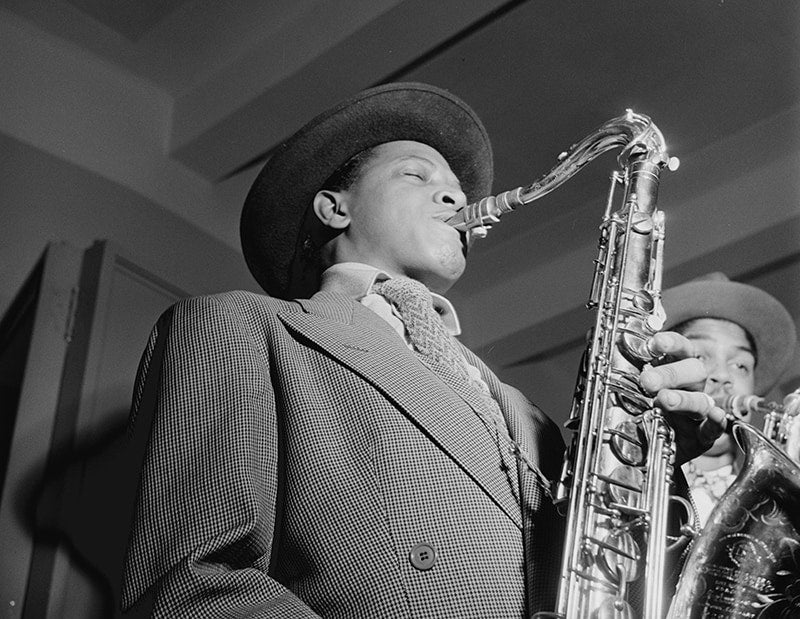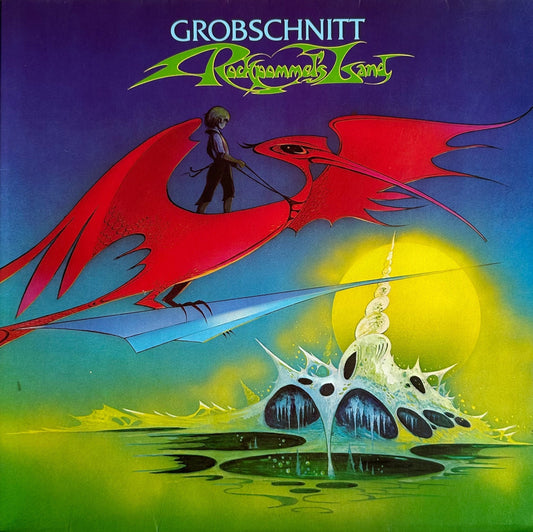Sometimes a career is all about meeting the right people at the right time. That was the case when teenaged alto saxophonist Jean-Baptiste Illinois Jacquet got to play for Nat “King” Cole, who then introduced him to Lionel Hampton. Hampton offered him a job in his band, but only if he would focus on tenor sax. The moment Jacquet agreed, a jazz legend was born.
Jacquet, the son of Louisiana Creoles, was born in 1922. His family moved to Houston when he was a young child, and he grew up in a household of siblings and parents who played instruments. The Hampton band’s record of the tune “Flying Home” in 1942 was Jacquet’s first studio experience. The single was a hit and became an in-demand live tune for Hampton, largely thanks to his solo.
Before he moved to New York City, Jacquet took advantage of the West Coast, playing on-screen in a couple of films, including the Lena Horne-led Stormy Weather. Meanwhile, he worked the chitlin’ circuit, the tour of vaudeville houses that welcomed Black artists. For a while he had a small group with Charles Mingus. But things really took off in 1946, when he moved east to replace the great Lester Young in the Duke Ellington Orchestra.
He worked steadily for the rest of his life, leading his own big band in the 1980s and becoming the first jazz musician named artist-in-residence at Harvard University. He died in 2004 in his longtime home of Jamaica, Queens, where a performance space in Prospect Cemetery is now named after him.
Enjoy these eight great tracks by Illinois Jacquet.
- Track: “I Wrote This for the Kid”
Album: The Kid and the Brute
Label: Clef/Verve
Year: 1954
This is from a duo recording with fellow saxophonist Ben Webster. Jacquet was the kid in the title, and Webster the brute. Jacquet is joined here by his brother trumpeter Russell Jacquet, with whom he often played.
Webster composed “I Wrote This for the Kid,” which opens Side A. The two lead players’ brash phrasing is in perfect sync. The contrastingly graceful decorations at the keyboard are provided by John Acea.
- Track: “Lullaby of the Leaves”
Album: Swing’s the Thing
Label: Clef
Year: 1956
The title of this album does not lie. Far from the angular proto-bop of the previous example, this album features the rich smoothness found in the best of swing bands. It helped to pack the studio with a power quintet: Jacquet plus Roy Eldridge (a particularly nice trumpet solo on this track), Jimmy Jones (piano), Herb Ellis (guitar), Ray Brown (bass), and Jo Jones (drums).
“Lullaby of the Leaves” is a Tin Pan Alley tune composed in 1932 by Bernice Petkere. As swing-era standards go, it’s somewhat unusual for having a lot of syncopation in its basic tune, offering layers of rhythmic potential for improvisation.
- Track: “Bassoon Blues”
Album: The Message
Label: Argo
Year: 1963
This was the first of two consecutive albums with guitarist Kenny Burrell. Jacquet is playing his own composition, “Bassoon Blues.” Ralph Smith is on organ.
It is common for saxophonists to have a good handle on flute or clarinet. But on this track, Jacquet offers his skills as a bassoonist, which is much less common. It’s a different technique: the bassoon is a double-reed instrument, notoriously hard to control in detailed passages, whereas clarinet and sax have a single-reed mouthpiece. That he can pull a swinging sound out of a bassoon is quite an impressive feat.
- Track: “Do I Love You”
Album: Bosses of the Ballad
Label: Argo
Year: 1964
Subtitled Illinois Jacquet and Strings play Cole Porter, this album utilizes arrangements by Tom McIntosh and Benny Golson performed by a 19-piece pickup orchestra. Oddly, given that subtitle, there are wind and percussion instruments along with the strings.
The arrangements are very much of their era: schmaltzy in timbre with that distinctive, lightly dissonant sheen that came to be known as “jazz harmony” among a certain set. But Jacquet is, of course, the real deal. Hopefully, if you can tone down the overreaching orchestra in your mind, you will appreciate this plaintive tenor saxophone rendition of a Gershwin classic.
- Track: “On a Clear Day (You Can See Forever)”
Album: Go Power!
Label: Cadet
Year: 1966
Jacquet’s sound always blended well with an organ, and this live album gives a heaping helping of evidence for that claim. Milt Buckner rocks the Hammond organ. Alan Dawson on drums completes the trio.
“On a Clear Day (You Can See Forever)” is the standard by Burton Lane and Alan Jay Lerner. The three musicians find a lot of humor in the melody, not to mention an unexpected Latin vibe that melds into a bebop free-for-all and then a sultry romp.
- Track: “Caravan”
Album: The King!
Label: Prestige
Year: 1968
There is hardly a greater tune than Duke Ellington’s “Caravan,” so it’s always worthwhile seeing what a top-notch artist has to say with this material. On The King! Jacquet attacks from below, leaning into the tune’s bass range as well as its exotic aspects on his bassoon.
The multifaceted textures in the background are provided by a combination of Montego Joe’s bongos and the plucked sounds of Billy Butler’s guitar and Al Lucas’ pizzicato bass. It’s a thoroughly original arrangement.
- Track: “Every Day I Have the Blues”
Album: The Blues; That’s Me!
Label: Prestige
Year: 1969
On The Blues; That’s Me! Jacquet leads a quintet with Wynton Kelly on piano, Tiny Grimes on guitar, Buster Williams on bass, and Oliver Jackson on drums. On this album, you can hear Jacquet inching his way into the R&B sound, while maintaining both swing and bebop elements.
“Every Day I Have the Blues” demonstrates this melting pot of genres admirably. The tune was written by Peter Chatman, a.k.a. Memphis Slim, a pianist who specialized in jump blues (think Fats Waller’s style). Jacquet’s group tempers the jump with a low-key, soulful energy.
- Track: “On the Sunny Side of the Street, No. 1”
Album: Illinois Jacquet with Milt and Jo
Label: Black and Blue
Year: 1974
The “Milt and Jo” in the title are Jacquet’s old friends, pianist (and sometime organist) Milt Buckner and drummer Jo Jones. Apparently, they couldn’t decide how they wanted to play the classic Depression-era “On the Sunny Side of the Street,” so they included two versions on this album.
While the second version has a standard swing sensibility, this first one has a harder-hitting two-feel, more vertical than horizontal motion, you might say. Roland Lobligeois corrals the proceedings with his rock-steady walking bassline.



